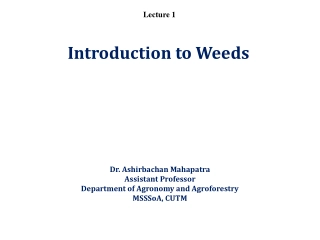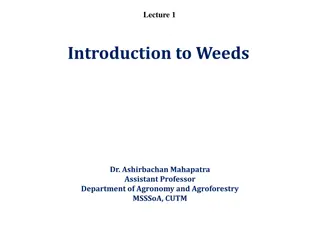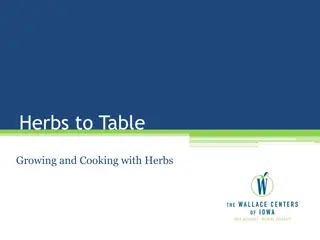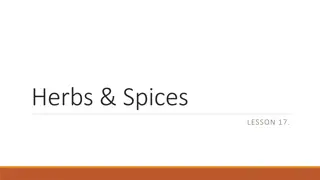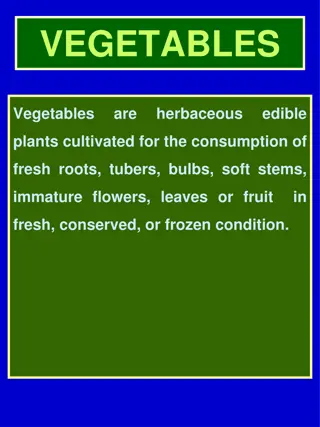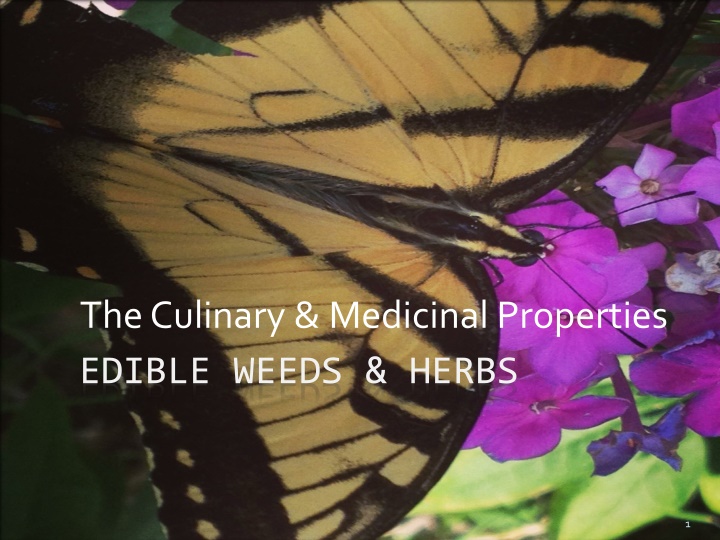
Culinary and Medicinal Properties of Edible Weeds and Herbs
Explore the diverse world of common garden weeds and herbs that have culinary and medicinal benefits. Learn about phytochemicals, antioxidants, hormonal actions, and how these natural elements work within the body to promote health and well-being. Discover the potential of these plants in supporting various health aspects, from reducing oxidative stress to imitating human estrogen. Delve into the interference with DNA replication and the physical actions of different compounds found in these plants.
Download Presentation

Please find below an Image/Link to download the presentation.
The content on the website is provided AS IS for your information and personal use only. It may not be sold, licensed, or shared on other websites without obtaining consent from the author. If you encounter any issues during the download, it is possible that the publisher has removed the file from their server.
You are allowed to download the files provided on this website for personal or commercial use, subject to the condition that they are used lawfully. All files are the property of their respective owners.
The content on the website is provided AS IS for your information and personal use only. It may not be sold, licensed, or shared on other websites without obtaining consent from the author.
E N D
Presentation Transcript
The Culinary & Medicinal Properties EDIBLE WEEDS & HERBS 1
Common Garden Weeds Amaranth Beef Steak Mint Chickweed Cleavers Couch grass Dandelions 2
Common Weeds & Herbs Day Lily Evening Primrose Green briars Hawthorn Berries Hosta Japanese Honey Suckle Lavender 3
Common Weeds & Herbs Juniper Berries Lamb s Quarters Marshmallow Root Mullein Plantain Purple Coneflower 4
Common Herbs & Weeds Prickly Pear Purslane Red Clover Turk s Cap Wood Sorrel Aloe 5
Phytochemicals What are phytochemicals How do phytochemicals work 1. Antioxidant 2. Hormonal Action 3. Stimulation of Enzymes 4. DNA Replication 5. Physical Action 6
Antioxidants Protects cells from oxidative stress Reduce getting certain cancers Allyl sulfides (onions, leeks, and garlic) Carotenoids(carrots and fruits) Flavonoids(fruits and veggies) Polyphenols( teas and grapes) 7
Hormonal Action Imitates human estrogen Helps reduces menopausal symptoms Reduces Osteoporosis Isoflavones (Red Clover, Soy, and Black Cohosh) 8
Stimulation of Enzymes Reduces Estrogen levels May prevent Breast Cancer Indoles (found in cabbage) Protease Inhibitors(beans and soy) Terpenes found in citrus and cherries 9
Interference with DNA Replication May help protect and reduce carcinogens Prevent multiplication of cancer cells Have anti-bacterial properties Allicin, saponins and capsaicin 10
Physical Action Proanthocyanidins a chain of flavonoids Cranberries are the most popular and well known of these groups 11
Other Phytochemicals Alkaloids Coumarins produces the vanilla like smell of clovers, Tonka beans, and sweet woodruff Tannins (Teas, bark of trees, acorns) Volatile Oils (highly scented herbs are all antiseptic, anti-inflammatory and antimicrobial 12
Edible Weeds & Herbs Uses Amaranth (Amaranthus) used as grain, hot cereal, leaf vegetable Dandelion (Taraxacum) used as tea, leaf vegetable, wine Green Briar(Smilax) tubers have starch, young leaves only with tendrils Prickly Pear Cactus (Opuntia) pads, fruit used in salads, vegetable , juice, tea Lambs Quarters (Chenopodium album) aka Pig Weed, leaf vegetable Turks Cap (Malvaviscus arboreus var. drummondii) flowers in salads or desserts Japanese Honeysuckle (Lonicera Japonica) teas, flowers, leaf vegetable Day Lily (Hemerocallis fulva) shoots, flowers, buds in salad, soups etc Hosta (funkia) shoots , leaves when young 13
Edible Weeds & Herbs Uses Beef Steak Mint( Perilla frutescens) Used in Asian dishes , leaves dipped in soy sauce Chickweed (Stellaria media) grown for human and poultry consumption, whole plant. Great cooling herb and considered a vegetable Cleavers (Galium aparine) very nutty flavor used as a tea, purifier of blood Purple Coneflowers(Echinacea Purpurea) Stimulates the immune system and well known for cold remedies . Roots and leaves are used Hawthorn Berries (Crataegus monogyna) leaves, berries, and flowers of hawthorn are used to make medicine. Hawthorn is used for diseases of the heart and blood vessels such as congestive heart failure (CHF), chest pain, irregular heartbeat, tapeworm and other intestinal infections. Juniper Berries (Juniperus communis) these berries are used for culinary in wild game, mixed with peppercorns, and have medicinal properties as well for heartburn, upset stomach, and wound healing 14
Edible Weeds & Herbs Uses Henbit (Lamium amplexicaule) Whole plant is edible akin to mint family but no mint flavor, throw in salads Purslane( Portulaca Oleracea) has medicinal as well as culinary aspect. It can be used in salads or on sandwiches, yum. It has the highest amount of vitamin A than any green leafy vegetable. Plantain (Plantago major) great culinary in salads, soups, or pot greens but as a healing herb it is wonderful for digestion, ulcers, and heart burns. Wood Sorrel (oxalis) culinary sour taste great in salads and seeds are also edible Red Clover(Trifolium pretense) Red clover is used for cancer prevention, indigestion, high cholesterol, whooping cough, cough, asthma, bronchitis, and sexually transmitted diseases (STDs). Some women use red clover for symptoms of menopause such as hot flashes; for breast pain or tenderness (mastalgia); and for premenstrual syndrome (PMS Couch grass (Elymus repens) great tea for bladder cystitis Lavender (Lavandula Angustifolia) teas, desserts, poultry 15
Spices in the Pantry used for Medicine Basil Digestion, Mental Fatigue, Tonic Bay Leaf Sprains, Rheumatism, Appetite Black Pepper constipation, nausea, arthritis Cardamom headaches, gas, indigestion Cayenne Circulation, Cramps, Digestion Cinnamon Antiseptic , astringent, stimulant Coriander Rheumatism, Appetite, Digestion Clove Nausea, toothache, rheumatism 16
Spices in the pantry used for Medicine Cumin gas, colic, diarrhea Garlic Antibiotic, heart , reduce blood pressure Ginger Inflammation, acid reflux, sore throat Horseradish Bronchitis, coughs, sciatica Marjoram colds, headaches, nervous disorders Mustard(ground) rheumatism, arthritis, congested lungs Nutmeg digestion, appetite, hallucinogenic Oregano Toothache, Coughs, Gallbladder 17
Spices in the Pantry used for Medicine Parsley Kidney, Mild laxative, insect bites Rosemary Circulation, depression, aching joints Sage Lung issues, digestion, antifungal Turmeric Inflammation, catarrh, blood issues Thyme Coughs, Colds, Stimulate white blood cells Vanilla Extract Toothache Curry Powder * Poultry Seasoning* 18
Resources http://www.ediblewildfood.com/ http://www.foragingtexas.com/ Amazon: Mrs Jack s Pantry: Herbs in the Kitchen Facebook: www.facebook.com/mjgardenofeve 19

